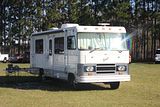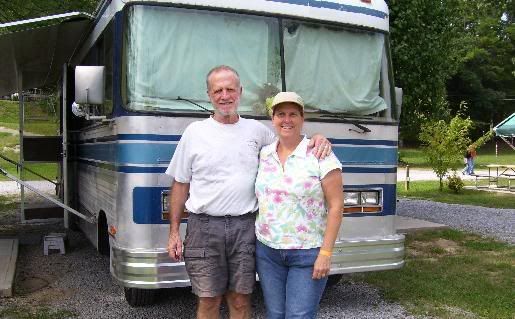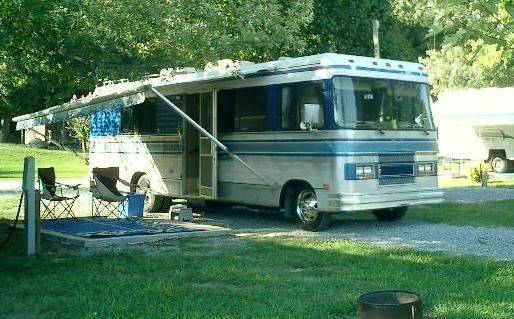Go to...  | Start A New Topic  | Search  | Notify  | Tools  | Reply To This Topic  |  |
 6/12 6/12Formally known as "Humbojb"  |
Tere and I dropped the tank on Old Blue, sent it off to have it redone, along with the in tank pick up. We also changed every fuel line from 5/16" to 3/8" marine grade rubber fuel lines. That was when we were young and crazy. Now we're just crazy. Hum (aka Jim)
| ||||||||||||
|
 3/23 3/23 |
Well got to test run the .071 jets, the mixture is really right where I would like it until there is adequate vacuum to pull the rods down to the economy run, (the large part of the rod in the jet orifice). So the way to fix this is with smaller metering rods, easy huh!!! Remember we are dealing with Nose!! There are all kinds of rods available for 1978 and older Q-jets but am unable to get any for a 81 and newer unit! Seems pre-78 are the preferred Q-jets by the Hot Rod guys. The math tells me a .039 rod would probably do the job. Any one know where there are a couple?? Hard to tell with this gauge just how lean the run is at cruise, would have to buy the expanded range gauge to get a good reading, not gonna spend another $125 actually it would be $250 BECAUSE a 0 to 4 volt oxygen sensor is also required, currently mine is 0 to 1 volts. Maybe, lean by this gauge is good!!! Engine seems to run well and even in this hot weather it is 90C. 1971 24 ft Barth Continental P30 chassis 350 engine | |||
|
 3/23 3/23 |
Hey Jim, when you went to the .375 fuel line did you fix the vapor lock?? Thanks! 1971 24 ft Barth Continental P30 chassis 350 engine | |||
|
 6/12 6/12Formally known as "Humbojb"  |
Tere tells me we didn't go to 3/8", just replaced all the fuel lines with marine grade 5/16". I'm going to check the 'hose' box since we have some left over. Will let you know. We never had any vapor lock problem if I remember correctly. We did have a starter problem but when we went to a mini starter and installed a good heat shield, that was solved. Hum (aka Jim)
| ||||||||||||
|
 3/23 3/23 |
Steve VW turned me onto the mini starter, mine also works fine, except the bolts keep coming loose and they are torqued a lot!! I did have to shim it considerably, maybe 10 shims in it right now, if there were more i would use them too. A P30 without vapor lock, what engine? 1971 24 ft Barth Continental P30 chassis 350 engine | |||
|
 7/17 7/17 |
I have never had a vapor lock issue with our coach. I know that my fuel system is different than the nose. i have an in tank fuel pump that runs to a fuel regulator. from regulator to engine mounted fuel pump. I think 1986 was when this change was made. 1986 31' Regal -1976 Class C 454/T400 P30 -350/T400 G30 twin cntr beds - 21' rear bath | |||
|
 3/23 3/23 |
Have you tried using Lok-tite on the starter threads? For the vapor lock add an electric fuel pump near the tank with a dash switch. Chances are 3 to 5 seconds resolves your problem so a momentary switch could work. Back in the day aluminum foil with lots of crinkles on the line between the pump and carburetor kept my 56 Dodge running in stalled Summer traffic. | |||
|
 3/23 3/23 |
It might be that The Glasnose is more susceptible to VP than other units on a P30 with a 454 engine. Seems DannyZ (when he had a Euro) and I have had the issue more than most. Memory serves his was an 80. Years ago after Doorman walked me through the clogged fuel filter issues on the return trip from Ohio I came upon a traffic jam and had a quick stop from a run at speed and had to pull off the road because it quit, further into the trip I stopped for gas and had to wait about a half an hour with the dog house open before it would restart. On other trips, the engine would miss and carry on after a slow down or gas stop until the fuel flow would over power or cool the vapored area. Even after all these years do not know where that hot area is located. Do have an electric fuel pump inline with the mechanical unit, installed as close to the tank selector valve as possible, this has helped some but not 100%. I tied this pump into an oil pressure switch and put in a bi-pass momentary switch to prime when/if needed. It has occurred to me that because the mechanical fuel pump has a fuel return line, that the electric pump does not create the pressure in the line before the mechanical pump that is needed to stop the fuel from vaporizing (assuming the hot spot is in that line). The electric pumps 30 GPH of fuel 4 psi, do not know what the mechanical does with the return line. Never put a pressure gauge in that line, do have one at the carburetor never was able to view it when the 454 was in vapor lock mode normal pressure is 4 to 6 psi. No, have not put Locktite on the starter bolts,,,good idea!! Damn I love this machine!!! 1971 24 ft Barth Continental P30 chassis 350 engine | |||
|
 3/23 3/23 |
I was not aware of return fuel lines for gasoline fuel pumps except for marine engines which really are diaphragm failure routes to dump the leaking gas into the carburetor throat. Can you block the return line without causing a problem? | |||
|
Glassnose Aficionado |
I put an electric in line pump in to aid the mechanical and it helped, but did not cure the problem. I also fabbed a heat shield that ran the entire length of the frame where it was close to the exhaust pipe, wrapped the line and the down pipe with heat tape, clothes pinned the line near the carb, and just about anything that was ever suggested to me. The lock always happened after I lifted the gas pedal for any amount of time, then accelerated again, so I know heat was boiling the gas somewhere in the line. As I understand it, the return line was a feeble attempt by GM to remedy the lock problem, the reasoning being that if gas was continuing to flow instead of sitting still in the line it wouldn't vaporize. The one thing I never tried was an electric fan to dissipate the heat around the manifold area. I have one on the 78 and I have never had a vapor lock problem with it, either with the manifolds or the Thorleys that are on it now. When I sold the Nose I told the gentleman about the problem and he wasn't concerned at all. When he got it home he called and told me it never hiccuped till he was on his own street, about 40 miles from here, and he was very happy. I never heard from him again. 79 Barth Classic | |||
|
 3/23 3/23 |
Almost seems like manifold vacuum is translating to the float bowl and causing it to boil. | |||
|
 3/23 3/23 |
Keep thinking the fuel line that runs from the mechanical fuel pump to the carburetor is the problem area. That line runs close to the engine and in the path of air going through the radiator, alcohol and gas boil at a low temperature, depending on the blend, brand and pressure, anywhere from 130 to 160F. So with that hot air and engine heat, that is a likely spot. One day that line will get rerouted away from the engine and as much as possible out of the path of radiator air. There is no return flow in this line so likely to heat up after flow to the engine is decreased. That line is under pressure though but only 4 to 6 psi. Not sure what the boiling point of gas is at that pressure. Just saw a video on U-Tube where a guy got a fuel filter with a vent port in it, installed it just in front of the carburetor and ran the vent back to the fuel tank. There is a small restriction in the filter return port exit to keep fuel pressure in the line. Supposedly this lets any vapor in the line exhaust to the fuel tank. I wonder if this port was tied into the existing fuel return line from the mechanical fuel pump if it would vent. Just thinking out load!! 1971 24 ft Barth Continental P30 chassis 350 engine | |||
|
 6/12 6/12Formally known as "Humbojb"  |
Duane, we replaced all the fuel lines in Old Blue with Shields alcohol/fuel rated 3/8" ID hose. Its' od was at least 1/2". Old Blue did not have an in tank fuel pump. It had two fuel tanks and change over stuff. The only fuel pump was the mechanical fuel pump running to the carb. We took off all the junk, except we retained the fuel line going back to the tank. It,too, was replaced with the Shields hose. That stuff is expensive. We never had any vapor lock. I drove it from Arizona to NC, to Indiana, to DC, and the new owner drove it to Seattle. The only time it stopped was before we replaced the starter. Hum (aka Jim)
| ||||||||||||
|
 3/23 3/23 |
Jim, if or maybe when The fuel lines get replaced on Nose, your advise will be the first item in the job!! Thank you so much!! The more I think about the vented filter, the less desirable it becomes. the carburetor filler bowl is vented, one would think as the float opens the filler valve if there was pressure and vapor it would vent into the carb intake. So perhaps there is no or very little pressure in that line during vapor lock. That means there is vapor before the mechanical fuel pump making it ineffective, unable to create any fuel flow pressure. This does assume vapor lock occurs while the engine is running. Now one would assume that the inline electric fuel pump is making pressure and one might wonder where that pressure is being vented? Faulty thinking, perhaps??? 1971 24 ft Barth Continental P30 chassis 350 engine | |||
|
Glassnose Aficionado |
I also think the lock was between the pump and the carb, as it would idle fine, and accelerate fine for maybe 6-8 seconds, then cut out. I learned to get up to speed asap so when it cut out the momentum would keep it going until it re-fired. While studying and working on the problem, I read somewhere that fuel lines should always be steel, never any kind of hose, except where hose was necessary such as junctions. I also agree that the line from the pump to the carb is routed very poorly, but I never tried re-routing it. 79 Barth Classic | |||
|
| Powered by Social Strata | Page 1 2 3 4 5 6 7 8 9 10 |
| Please Wait. Your request is being processed... |
|
This website is dedicated to the Barth Custom Coach, their owners and those who admire this American made, quality crafted, motor coach.
We are committed to the history, preservation and restoration of the Barth Custom Coach.
We are committed to the history, preservation and restoration of the Barth Custom Coach.



